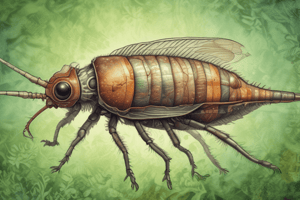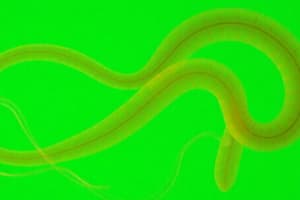Podcast
Questions and Answers
How is cysticercosis different from taeniasis?
How is cysticercosis different from taeniasis?
Cysticercosis is an infection of larval stages in humans and pigs, while taeniasis is an intestinal infection with the adult tapeworm.
How are humans usually exposed to Taenia solium eggs?
How are humans usually exposed to Taenia solium eggs?
Humans are usually exposed to eggs by ingestion of food/water contaminated with feces containing these eggs or proglottids.
What happens to oncospheres after ingestion by humans?
What happens to oncospheres after ingestion by humans?
Oncospheres hatch in the intestine, invade the intestinal wall, enter the bloodstream, and migrate to multiple tissues and organs where they mature into cysticerci over 60-70 days.
What can cause neurocysticercosis?
What can cause neurocysticercosis?
How can humans acquire intestinal infections with T.solium?
How can humans acquire intestinal infections with T.solium?
How do adult tapeworms attach to the small intestine?
How do adult tapeworms attach to the small intestine?
What is the primary location where eggs of Echinococcus granulosus hatch after ingestion by an intermediate host?
What is the primary location where eggs of Echinococcus granulosus hatch after ingestion by an intermediate host?
What is the function of the protoscolices in the life cycle of Echinococcus granulosus?
What is the function of the protoscolices in the life cycle of Echinococcus granulosus?
What is the most common clinical manifestation of Echinococcus granulosus infections in humans?
What is the most common clinical manifestation of Echinococcus granulosus infections in humans?
What can occur if hydatid cysts rupture in humans?
What can occur if hydatid cysts rupture in humans?
What is the role of canids in the life cycle of Echinococcus granulosus?
What is the role of canids in the life cycle of Echinococcus granulosus?
What is the term for the six-hooked larvae that penetrate the intestinal wall and migrate to various organs?
What is the term for the six-hooked larvae that penetrate the intestinal wall and migrate to various organs?
What are the preventive measures to avoid Dyphillobothrium latum infection?
What are the preventive measures to avoid Dyphillobothrium latum infection?
Describe the characteristic feature of the terminal proglottids of Dyphillobothrium latum.
Describe the characteristic feature of the terminal proglottids of Dyphillobothrium latum.
What are the intermediate hosts for the life cycle of Dyphillobothrium latum?
What are the intermediate hosts for the life cycle of Dyphillobothrium latum?
What is the infectious stage for the definitive host in the life cycle of Dyphillobothrium latum?
What is the infectious stage for the definitive host in the life cycle of Dyphillobothrium latum?
What is the characteristic rosette-shaped structure found in Dyphillobothrium latum?
What is the characteristic rosette-shaped structure found in Dyphillobothrium latum?
How long can adult Dyphillobothrium latum worms grow and how many proglottids can they have?
How long can adult Dyphillobothrium latum worms grow and how many proglottids can they have?
What is the role of arthropods in the life cycle of Hymenolepis nana?
What is the role of arthropods in the life cycle of Hymenolepis nana?
How are the eggs of Hymenolepis nana immediately infective to hosts?
How are the eggs of Hymenolepis nana immediately infective to hosts?
What is the fate of the cysticercoids in the host's intestine?
What is the fate of the cysticercoids in the host's intestine?
What differentiates Hymenolepis nana var. fraterna from Hymenolepis nana?
What differentiates Hymenolepis nana var. fraterna from Hymenolepis nana?
How do the eggs of Hymenolepis nana infect humans or rodents?
How do the eggs of Hymenolepis nana infect humans or rodents?
How are the eggs of Hymenolepis nana released from the host's body?
How are the eggs of Hymenolepis nana released from the host's body?
What is the role of larger predator species in the life cycle of diphyllobothriids?
What is the role of larger predator species in the life cycle of diphyllobothriids?
How do adult diphyllobothriids attach themselves to the intestinal mucosa of the definitive host?
How do adult diphyllobothriids attach themselves to the intestinal mucosa of the definitive host?
What are the common symptoms experienced by patients with diphyllobothriasis?
What are the common symptoms experienced by patients with diphyllobothriasis?
What is the primary method of preventing diphyllobothriasis in humans?
What is the primary method of preventing diphyllobothriasis in humans?
What is the definitive host specificity among medically important diphyllobothriids?
What is the definitive host specificity among medically important diphyllobothriids?
Describe the life cycle of a Hymenolepis nana, including its size and preferred location in the body.
Describe the life cycle of a Hymenolepis nana, including its size and preferred location in the body.
Flashcards are hidden until you start studying




